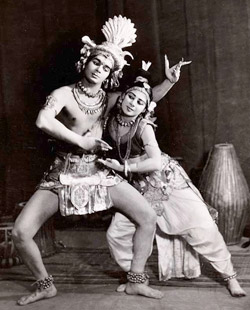|
Uday Shankar
Life and times of a dedicated artiste
by Subashini Pathmanathan
An artiste's life is a constant struggle. Normally after a lifelong
battle their contributions get the social recognition. But after their
period, their great contributions and sacrifices are very often
forgotten.
|

Uday Shanker on stage |
Uday Shanker was born in the village of Udaipur, in a rich Zamindahri
Brahmin family on December 8, 1900. When he was young he travelled all
over India. He travelled from place to place in different states as his
father was in the state service. Ultimately the family settled down in
Jhalawar. When he was small he got numerous opportunities to watch a
variety of dances. This was during the Holi festival time.
Dances fascinated and influenced Shanker's young mind. In his
childhood he lived in his paternal grandfather's house, while his father
was away on lecture tours abroad. During his childhood he lived in
different states of India such as Rajasthan, Uttar Pradesh and Bengal.
Different celebrations of festivals influenced young Uday Shankar.
With the young boys he had a carefree life: swimming in the River
Ganges and viewing street dances such as Nautanki and Baiji. Mother
couldn't control him due to the restricted life of the female freedom.
All these in his inner subconscious mind influenced and moulded his own
creativity which helped him develop his own dances later in his life.
Pranks
Many orthodox Hindu families didn't accept his pranks. An artiste
realised his inborn talents and helped him to develop his talents. His
mother had no daughters, so she dressed him as a female. Just for
amusement he dressed himself as a woman and danced. He also performed
his famous Malwari dance in Paris. No one believed that it was a male
dancer who danced as a female. Almost at the end of the First World War,
his father returned to India from London. And their family shifted to
Jhalawar. His father realised his son's exceptional talents in painting
and Indian instrumental music.
In 1918 he was sent to the J.J School of Arts, Bombay, and in 1920,
Shanker sailed to London to learn art at the Royal Art School, where his
exceptional talents were recognised The principle of the school asked
him to study paintings and miniatures in the British Museum. With the
influence of certain Indians he understood the rich culture of India.
His study and research at the British museum thrilled him.
During his time only he was influenced by aesthetic arts of Indian
paintings, music, and dance. He was the first Indian to have won two
prizes for self portrait. Moreover, he received a scholarship to Rome
where he met Anna Pavlova.
Choreographer
 Unexpectedly fate brought both of them together. She requested
Shanker to choreograph a dance show. He also agreed to do so and danced
with her later she became a partner in his dance show. Unexpectedly fate brought both of them together. She requested
Shanker to choreograph a dance show. He also agreed to do so and danced
with her later she became a partner in his dance show.
Through hard work, he choreographed two items, Radha- Krishna, and
Hindu marriage. They were produced in London and won international fame.
Actually it was the starting point for his professional dance career.
Anna Pavlova invited him to join her American tour. Unfortunately less
opportunity was given to him by Anna Pavlova's troupe in the American
tour.
Due to such disappointments he left Anna Pavlova' troupe as soon as
he returned from the American tour. Then he returned to Paris and worked
hard and rehearsed his own imaginative creative dance based on rich
Indian culture. During that period his exceptional talent was very much
influenced by Ananda K. Commaraswamy's Mirror of Gesture the English
translation of Abiynaya Darpana of Nandikeswara.
Simike, a pianist, joined his troupe to help him in the orchestra and
in the dance troupe. In 1925, he performed at the Exposition of
International in Paris. It gave an opportunity for him to see the dances
of different countries including Africa, America, Arabia, Java, and Bali
including the Kandyan dance of Sri Lanka. All these influenced his
creative dance form. His graceful creative dances also attracted the
local audience of Paris which provided an opportunity to have his show
all over from France.
Indian art
On his return to India he studied Indian art and watched the
performances of court dancers and musicians.
He was very much taken up by the folk dances and their aesthetic
essence. He was very much attracted by Kathakali.
He also saw the majestic sculptures of gods and temple decorations.
He visited the famous temples such as Chidamparam and Knorak including
Ajantha, Ellora, Haliberd. He also visited Shanthiniketan where he met
Rabindranath Tagore.
After the second World War Uday Shakar was involved in his film
Kalpana which proved a financial flop.
Once his wife Aloma said, "I owe to my husband a new vision of life"
With the passage of time he moved to Calcutta where his health
started deteriorating.
While he was performing in Assam, he got a heart attack. Following a
performance in the USA he passed away on September 26, 1977. |

